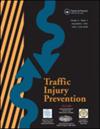模拟驾驶的认知负荷如何影响听觉注意力的大脑动态。
IF 1.6
3区 工程技术
Q3 PUBLIC, ENVIRONMENTAL & OCCUPATIONAL HEALTH
引用次数: 0
摘要
目标:分心驾驶是机动车撞车事故的主要原因,也是造成青少年伤亡的主要原因。虽然注意力和工作记忆显然是驾驶能力的基础,但很少有研究从大脑层面探讨这些功能在驾驶认知负荷下的表现。为了了解驾驶对听觉注意力处理造成的负荷,我们研究了在LOAD(在高仿真驾驶模拟器中驾驶)和No-LOAD(坐在模拟器中,停在路边)条件下大脑对听觉刺激的动态反应差异:27名年轻的成年驾驶员(18-27岁,其中15名为女性)在½驾驶室迷你模拟器(miniSim®)高保真驾驶模拟器中完成了在 "负载"(驾驶)和 "非负载 "条件下的选择性听觉注意任务。在任务过程中,当目标音出现在目标耳部时,参与者按下方向盘上的音量控制按钮做出反应。在两个反应窗口(早期:150-330 毫秒;晚期:350-540 毫秒)中,通过阿尔法和θ 振荡评估了脑电图记录的大脑对目标音的事件相关反应:在早期的时间窗口中,我们观察到在右侧额叶皮质区域,注意/不注意与 LOAD/No-LOADθ 功率之间存在显著的交互作用(F(1, 24)= 5.4, p=.03, partial η2=.18)。在稍后的窗口期,我们观察到在后部皮层区域(F(1, 24)=11.81, p=.002, partial η2=.15)和右侧颞叶皮层区域(F(1, 24)=4.3, p=.05, partial η2=.33),有注意/无注意与 LOAD/No-LOAD α反应之间存在显著的交互作用:我们的数据让我们深入了解了驾驶对认知能力的要求,以及双重任务的参与如何会占用驾驶资源。我们建议未来的研究直接将车辆控制能力纳入研究设计,以了解基于大脑的测量与驾驶行为之间的关系。本文章由计算机程序翻译,如有差异,请以英文原文为准。
How the cognitive load of simulated driving affects the brain dynamics underlying auditory attention
Objective
Distracted driving is a primary contributor to for motor vehicle crashes, the leading cause for injuries and fatalities for youth. Although attention and working memory clearly underlie driving abilities, few studies explore these functions on the brain-level under the cognitive load of driving. To understand the load driving has on auditory attention processing, we examined the differences in dynamic brain response to auditory stimuli during LOAD (while driving in a high-fidelity driving simulator) and No-LOAD conditions (seated in simulator, parked on the side of the road).
Methods
Twenty-seven young adult drivers (18–27 y/o; 15 = women) completed a Selective Auditory Attention Task during both a LOAD (driving) and No-LOAD condition in a ½ cab miniSim® high-fidelity driving simulator. During the task, participants responded by pressing the volume control button on the steering wheel when a target tone was presented to a target ear. Electroencephalography-recorded event-related brain responses to the target tones were evaluated through alpha and theta oscillations for two response windows (early: 150–330ms; late: 350–540ms).
Results
During an early time window, we observed a significant interaction between attended/unattended and LOAD/No-LOAD theta power in the right frontal cortical region (F(1, 24)= 5.4, p=.03, partial η2=.18). During the later window, we observed a significant interaction between attended/unattended and LOAD/No-LOAD alpha response in the posterior cortical region (F(1, 24)=11.81, p=.002, partial η2=.15) and in the right temporal cortical region during the window (F(1, 24)=4.3, p=.05, partial η2=.33).
Conclusions
Our data provide insight into the demand that driving has on cognitive faculties and how dual task engagement may draw resources away from driving. We suggest future research directly incorporate vehicle control abilities into study design to understand how brain-based measures relate to driving behaviors.
求助全文
通过发布文献求助,成功后即可免费获取论文全文。
去求助
来源期刊

Traffic Injury Prevention
PUBLIC, ENVIRONMENTAL & OCCUPATIONAL HEALTH-
CiteScore
3.60
自引率
10.00%
发文量
137
审稿时长
3 months
期刊介绍:
The purpose of Traffic Injury Prevention is to bridge the disciplines of medicine, engineering, public health and traffic safety in order to foster the science of traffic injury prevention. The archival journal focuses on research, interventions and evaluations within the areas of traffic safety, crash causation, injury prevention and treatment.
General topics within the journal''s scope are driver behavior, road infrastructure, emerging crash avoidance technologies, crash and injury epidemiology, alcohol and drugs, impact injury biomechanics, vehicle crashworthiness, occupant restraints, pedestrian safety, evaluation of interventions, economic consequences and emergency and clinical care with specific application to traffic injury prevention. The journal includes full length papers, review articles, case studies, brief technical notes and commentaries.
 求助内容:
求助内容: 应助结果提醒方式:
应助结果提醒方式:


